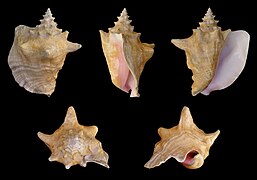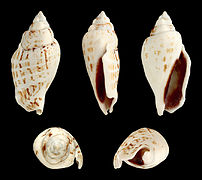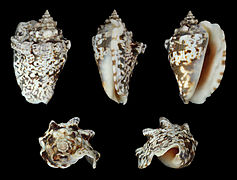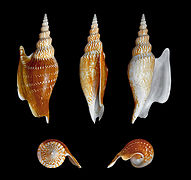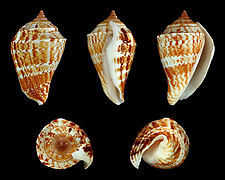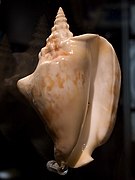Strombidae
| Strombidae | |
|---|---|
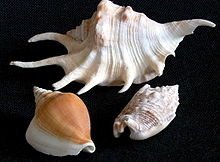
| |
| Three shells of three species in the family Strombidae: lower left Laevistrombus turturella, upper center Lambis lambis, lower right Euprotomus aurisdianae | |
| Scientific classification | |
| Domain: | Eukaryota |
| Kingdom: | Animalia |
| Phylum: | Mollusca |
| Class: | Gastropoda |
| Subclass: | Caenogastropoda |
| Order: | Littorinimorpha |
| Superfamily: | Stromboidea |
| Family: | Strombidae Rafinesque , 1815
|
| Genera | |
|
See text | |
Strombidae,
Distribution
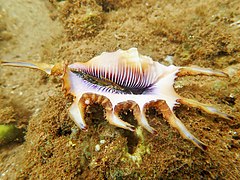
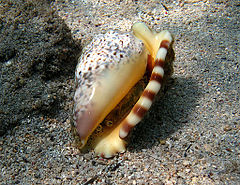
Strombid gastropods live mainly in
Morphology and life habits
Strombids have long eye stalks. The shell of a strombid has a long and narrow aperture and a siphonal canal. The shell margin has an indentation near the anterior end which accommodates one of the eye stalks. This indentation is called a strombid or stromboid notch. The stromboid notch may be more or less conspicuous, depending on the species.[6] The shells of most species in this family grow a flared lip upon reaching sexual maturity. They lay eggs in long, gelatinous strands. The genera Strombus and Lambis have many similarities between them, both anatomical and reproductive, though their shells show some conspicuous differences.
Strombids were widely accepted as
Behavior
Unlike most snails, which glide slowly across the substrate on their feet, strombid gastropods have a characteristic means of locomotion, using their pointed, sickle-shaped, horny operculum to propel themselves forward in a so-called leaping motion.[1][9]
Burrowing behavior, in which an individual sinks itself entirely or partially into the substrate, is also frequent among strombid gastropods. The burrowing process itself, which involves distinct sequential movements and sometimes complex behaviors, is very characteristic of each species. Usually, large strombid gastropods, such as the queen conch
Taxonomy
For a long time, all conchs and their allies (the strombids) were classified in only two genera, namely Strombus and Lambis. This classification can still be found in many textbooks and on websites on the internet. Based on
Genera
The family Strombidae actually comprises 26 extant genera and 10 extinct genera (marked with a dagger †).[11][13]
- Extant genera
- Aliger Thiele, 1929
- Barneystrombus Blackwood, 2009
- Canarium Schumacher, 1817
- Conomurex Bayle in P. Fischer, 1884
- Dolomena Wenz, 1940
- Doxander Wenz, 1940
- Euprotomus Gill, 1870
- Gibberulus Jousseaume, 1888
- Harpago Mörch, 1852
- Labiostrombus Oostingh, 1925
- Laevistrombus Abbott, 1960
- Lambis Röding, 1798
- Lentigo Jousseaume, 1886
- Lobatus Swainson, 1837
- Macrostrombus Petuch, 1994
- Maculastrombus Liverani, Maxwell, Dekkers, 2021
- Neostrombus Liverani, Maxwell, Dekkers, 2021
- Neodilatilabrum Dekkers, 2012
- Mirabilistrombus Kronenberg, 1998
- Ministrombus Dekkers, 2010
- Ophioglossolambis Dekkers, 2012
- Persististrombus Kronenberg & Lee, 2007
- Sinustrombus Bandel, 2007
- Strombus Linnaeus, 1758
- Terestrombus Kronenberg & Vermeij, 2002
- Thetystrombus Dekkers, 2008
- Thersistrombus Bandel, 2007
- Titanostrombus Petuch, 1994
- Tricornis Jousseaume, 1886
- Tridentarius Kronenberg & Vermeij, 2002
- Extinct genera
- †Austrombus Nielsen, 2005
- †Carinrostrina De Gregorio, 1894
- †Dilatilabrum Cossmann, 1904
- †Europrotomus Kronenberg & Harzhauser, 2011
- †Oostrombus Sacco, 1893
- †Orthaulax Gabb, 1873
- †Striatostrombus Dekkers & Maxwell, 2018
- †Strombiconus Marks, 1951
- †Stromboconus De Gregorio, 1896
- †Volutostrombus Garvie, 2013
- Genera brought into synonymy
- Afristrombus Bandel, 2007 is a synonym of Persististrombus Kronenberg & Lee, 2007
- Aliger Thiele, 1929 is a synonym of Lobatus Swainson, 1837
- Decostrombus Bandel, 2007 is a synonym of Conomurex Bayle in P. Fischer, 1884
- Eustrombus Wenz, 1940 is a synonym of Lobatus Swainson, 1837
- Fusistrombus Bandel, 2007 is a synonym of Canarium Schumacher, 1817
- Gallinula Mörch, 1852 is a synonym of Labiostrombus Oostingh, 1925
- Hawaiistrombus Bandel, 2007 is a synonym of Canarium Schumacher, 1817
- Heptadactylus Mörch, 1852 is a synonym of Lambis Röding, 1798
- Latissistrombus Bandel, 2007 is a synonym of Sinustrombus Bandel, 2007
- Millipes Mörch, 1852 is a synonym of Lambis Röding, 1798
- Ministrombus Bandel, 2007 is a synonym of Dolomena Wenz, 1940
- Monodactylus Mörch, 1852 is a synonym of Euprotomus Gill, 1870
- Margistrombus Bandel, 2007 is a synonym of Neodilatilabrum Dekkers, 2008
- Pterocera Lamarck, 1799 is a synonym of Lambis Röding, 1798
- Pyramis Röding, 1798 is a synonym of Strombus Linnaeus, 1758
- Solidistrombus Dekkers, 2008 is a synonym of Sinustrombus Bandel, 2007
- Strombella Schlüter, 1838 is a synonym of Strombus Linnaeus, 1758
- Strombidea Swainson, 1840 is a synonym of Canarium Schumacher, 1817
Phylogeny
| |||||||||||||||||||||||||||||||||
| Phylogeny and relationships of the Strombidae according to Simone (2005)[6] |
The most recent revision of Maxwell 2019 (ZooKeys 867:1-7) new crown clade Neostromboidae to separate the Strombidae, Rostellariidae, and Seraphsidae from their sister families Struthiolariidae and Aporrhaidae. There is significant value to understanding evolutionary processes within Stromboidea to recognise the universal similarity in the position of the eye on the end of peduncles and a diminished cephalic tentacle that arises from the middle to the end on that peduncle. This is in contrast to other members of the Stromboidea where the eye is located at the base of the cephalic tentacle. These physiological differences represent two set of organisms with divergent and independent evolutionary life histories and therefore these differences need to be identifiable within the nomenclature to bring meaning to the way we name things.new crown clade Neostromboidae to separate the Strombidae, Rostellariidae, and Seraphsidae from their sister families Struthiolariidae and Aporrhaidae. There is significant value to understanding evolutionary processes within Stromboidea to recognise the universal similarity in the position of the eye on the end of peduncles and a diminished cephalic tentacle that arises from the middle to the end on that peduncle. This is in contrast to other members of the Stromboidea where the eye is located at the base of the cephalic tentacle. (from Maxwell et al. 2019) (https://www.researchgate.net/publication/334746905_Recognising_and_defining_a_new_crown_clade_within_Stromboidea_Rafinesque_1815_Mollusca_Gastropoda)
Historically the phylogenetic relationships among the Strombidae have been mainly accessed on two occasions, using two methods. In a 2005
| ||||||||||||||||||||||||||||||||||||||||||||||||||||||||||||||||||||||||||||||||||||||||||||||||||||||||||||||||||||||||||||||||||||||||||||||||||||||||||||||||||||||||||||||||||||||||||
| Phylogeny and relationships of Strombidae according to Latiolais (2006)[8] |
A different approach, this time based on sequences of nuclear
Human use
Snails in the family Strombidae are used by humans in a wide range of ways, mostly as food or decoration. Several species belonging to numerous genera among the Strombidae are considered economically important. Some species have been used in human culture for centuries. Since before the
References
- ^ ISBN 0-9661720-0-0.
- ^ Goodenough, W. H. & Sugita, H. (1980). "Trukese-English dictionary". Philadelphia: American Philosophical Society. p. 235]
- ^ ISBN 0-643-05756-0.
- ^ Abbott, R.T. (1960). "The genus Strombus in the Indo-Pacific". Indo-Pacific Mollusca 1(2): 33-144
- ^ ISSN 0042-3211.
- ^ ISSN 0066-7870.
- ^ Robertson, R. (1961). "The feeding of Strombus and related herbivorous marine gastropods". Notulae Naturae of the Academy of Natural Sciences of Philadelphia (343): 1–9.
- ^ .
- ^ Parker, G. H. (1922). "The leaping of the stromb (Strombus gigas Linn.)". Journal of Experimental Zoology 36: 205-209.
- ISSN 0341-0145.
- ^ a b c d Strombidae Rafinesque, 1815. Retrieved through: World Register of Marine Species on 18 May 2019.
- ^ Dekkers, A.M. (2012). "A new genus related to the genus Lambis Röding, 1798 (Gastropoda: Strombidae) from the Indian Ocean". Gloria Maris. 51 (2–3): 68–74.
- ^ Wieneke, U.; Stoutjesdijk, H.; Simonet, P.; Liverani, V.; Heitz, A. "Strombidae". Gastropoda Stromboidea. Retrieved 21 May 2019.
- ^ Squires, K. (1941). "Pre-Columbian Man in Southern Florida" (PDF). Tequesta (1). Florida International University: 39–46.
- ]
Further reading
- Roy K. (1996). "The roles of mass extinction and biotic interaction in large-scale replacements: a reexamination using the fossil record of stromboidean gastropods". Paleobiology 22(3): 436–452. pdf JSTOR
- Roy K., Balch D. P. & Hellberg M. E. (2001). "Spatial patterns of morphological diversity across the Indo-Pacific: analyses using strombid gastropods".
External links
- Gastropoda Stromboidea - Ulrich Wieneke and Han Stoutjesdijk
- Worldwide Conchology Strombidae
- Strombidae Lambis Eye - photographs
- The difference between a conch and a whelk [1]

